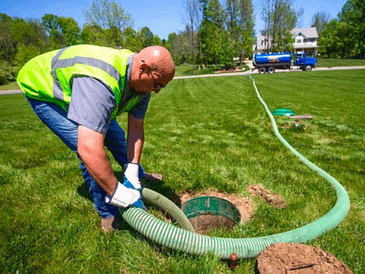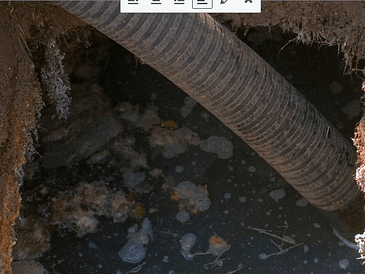Understanding the Signs of an Unhealthy Septic Tank: What to Look for
Imagine the serene tranquility of your home, nestled in the heart of nature. The air is crisp, and the surrounding landscape is a breathtaking sight to behold. However, hidden beneath this idyllic setting lies a crucial component responsible for managing your household waste: the septic tank. While often overlooked, a healthy septic system is vital for maintaining a hygienic and functional home. In this comprehensive guide, we will delve into the signs that indicate an unhealthy septic tank and equip you with the knowledge to address potential issues before they escalate.
Unpleasant odors permeating your property, backed-up drains causing frustration, or unexplained wet spots appearing in your yard can all be indicators of an impending septic tank problem. By understanding these warning signs and taking prompt action, you can save yourself from costly repairs and ensure a smooth-running system. So buckle up as we embark on a journey through septic system troubleshooting, maintenance strategies, and expert tips that will keep your septic tank running optimally for years to come.
The First Sign of Trouble: A Foul Odor from Your Septic Tank
One of the earliest indicators that your septic tank may be experiencing problems is the presence of a foul odor emanating from it. Imagine stepping out into your yard on a beautiful sunny morning, only to be greeted by an unpleasant stench that makes you recoil. This distinctive smell, often described as resembling rotten eggs or sewage, can be a clear indication that something is amiss with your septic system.
The foul odor results from the buildup of gases such as hydrogen sulfide and methane within the septic tank. These gases are byproducts of the decomposition process that occurs inside the tank. Under normal circumstances, they are safely vented through plumbing vents on your roof or through charcoal filters in certain systems. However, when there is a malfunction within the tank, these gases can escape into the air around it, creating an unmistakable and unwelcome scent.
While encountering a foul odor may initially seem disheartening, it actually presents an opportunity for proactive action. By promptly addressing this issue and investigating its underlying causes, you can prevent further damage to your septic system and avoid more serious consequences down the line. Remember, detecting this early sign of trouble allows you to take control of the situation and restore harmony to both your yard and your olfactory senses.
Understanding Common Septic System Problems
Septic systems are an integral part of residential and commercial properties, responsible for the safe disposal of wastewater. However, they are not immune to problems that can jeopardize their efficiency and functionality. In order to ensure the smooth operation of your septic system, it is crucial to familiarize yourself with some common issues that may arise.
One prevalent problem that plagues septic systems is blockage or clogging of the pipes. This can occur due to various factors such as excessive accumulation of solid waste, buildup of grease and oil, or intrusion from tree roots. When pipes become obstructed, wastewater cannot flow freely through the system, leading to backups and potential damage.
Another common issue is the failure of drain fields or leach fields. These essential components of septic systems are responsible for treating and dispersing wastewater into the surrounding soil. However, factors such as soil compaction, excessive water usage, or improper maintenance can cause these drain fields to become clogged or saturated. As a result, untreated wastewater may resurface on your property or even contaminate nearby water sources.
In addition to pipe blockages and drain field failures, septic tanks themselves can experience problems as well. One notable issue is tank deterioration caused by corrosion or structural damage over time. This can lead to leaks and cracks in the tank walls or lid, allowing groundwater infiltration or sewage leakage into the surrounding environment.
The Importance of Regular Septic Tank Inspection
Regular septic tank inspection is a vital component of responsible homeownership. By scheduling periodic inspections, you can ensure that your septic system is functioning optimally and catch any potential issues before they escalate into expensive and disruptive problems.
A comprehensive inspection involves a thorough examination of the entire septic system, including the tank itself, drain field, distribution box, and associated pipes. This process allows professionals to assess the overall health of your system, identify any signs of wear or damage, and determine if there are any blockages or leaks that need immediate attention.
Investing in regular septic tank inspections not only safeguards your property but also contributes to environmental preservation. A well-maintained septic system prevents harmful pollutants from entering local water sources and helps maintain a balanced ecosystem. By taking proactive steps towards regular inspections, you are actively participating in the preservation of our natural resources for future generations to enjoy.
The Role of Bacteria in Maintaining a Healthy Septic Tank
When it comes to the health of your septic tank, bacteria play a vital role that often goes unnoticed. These microscopic organisms are the unsung heroes of your septic system, working tirelessly to break down and digest organic matter. By understanding the crucial role bacteria play in maintaining a healthy septic tank, you can take proactive steps to nurture their presence and ensure the longevity of your system.
Beneficial bacteria are responsible for the decomposition process within your septic tank. As waste enters the tank, these bacteria begin to break it down into simpler compounds through a process called digestion. This breakdown is essential for preventing clogs and maintaining proper drainage in your system. Without these diligent bacteria, waste would accumulate and lead to blockages, foul odors, and potential damage to your entire septic infrastructure.
To ensure an optimal environment for these helpful bacteria, it is important to be mindful of what enters your septic system. Harsh chemicals or excessive use of antibacterial soaps can disrupt the delicate balance within the tank and harm the beneficial bacteria population. Opting for eco-friendly cleaning products and minimizing the use of antibacterial agents can safeguard these microscopic workers.
The Lifeline for Your Septic Tank: Septic Tank Pumping
Your septic tank is the unsung hero of your property, silently working day in and day out to safely process and dispose of wastewater. However, even the most reliable septic systems require regular maintenance to function optimally. That is where septic tank pumping comes in – a process that ensures the health and longevity of your entire system.
Septic tank pumping involves removing accumulated sludge and scum from the tank, preventing potential issues such as clogs, backups, and system failure. This vital maintenance task should be performed every three to five years, depending on factors like household size and water usage.
By scheduling routine septic tank pumping, you not only safeguard against costly repairs but also contribute to preserving the environment. Properly maintaining your septic system helps prevent contamination of groundwater sources and protects surrounding ecosystems. So embrace this crucial task as an opportunity to care for both your property and Mother Nature.
Addressing and Troubleshooting Septic Tank Issues
When it comes to addressing and troubleshooting septic tank issues, prompt action is crucial to prevent further damage and costly repairs. It is essential to be aware of the common problems that can arise with your septic system and take appropriate steps to rectify them.
The first step in troubleshooting septic tank issues is identifying the problem. If you notice slow drains, gurgling sounds from the plumbing, or sewage backups in your home, these are telltale signs of a potential issue with your septic system. It could be a problem with the drain field, clogged pipes, or a malfunctioning pump. By paying attention to these warning signs, you can address the issue promptly.
Next, it’s important to enlist professional help for proper diagnosis and repair. While some minor issues like clogs can be resolved through simple measures such as plunging or using enzyme-based cleaners, larger problems require professional expertise. Hiring a licensed septic tank technician will ensure that the problem is accurately identified and handled with precision. They will have specialized tools and knowledge to assess the condition of your tank and perform any necessary repairs or replacements.
Preventive maintenance plays a key role in troubleshooting septic tank issues. Regular inspection and maintenance are vital to identifying potential problems before they escalate into major concerns. By scheduling routine inspections, you can detect early warning signs of system failure or damage. Additionally, practicing good habits such as conserving water usage, avoiding flushing non-biodegradable materials down the toilet, and regularly pumping your septic tank will significantly reduce the risk of encountering troublesome issues in the future.
 The Key to a Healthy Septic System: Prioritizing System Health
The Key to a Healthy Septic System: Prioritizing System Health
When it comes to maintaining a healthy septic system, one of the most crucial aspects is prioritizing the overall health of the system. This involves taking proactive steps to prevent any potential issues and ensuring that your septic tank functions optimally for years to come.
First and foremost, regular inspection and maintenance are essential. By scheduling routine inspections, you can catch any minor problems before they escalate into major septic disasters. Professional inspectors can assess the condition of your tank, identify signs of damage or blockages, and recommend appropriate solutions. Remember, prevention is always better than cure when it comes to your septic system.
Another key aspect of prioritizing system health involves being mindful of what goes down the drains in your household. It’s important to educate everyone in your home about what should and shouldn’t be disposed of via sinks and toilets. Avoid flushing non-biodegradable items, such as wet wipes or sanitary products, as they can clog drains and cause severe damage to your septic tank. By practicing responsible waste disposal habits, you’re actively contributing to a healthier septic system.
The Essential Process of Septic Tank Cleaning
Proper cleaning and maintenance of your septic tank are essential to ensure its longevity and efficient operation. Regular cleaning not only prevents major issues but also helps maintain a healthy environment around your property. Let’s delve into the crucial steps involved in the septic tank cleaning process.
1. Inspection and Pumping: The first step in septic tank cleaning is inspecting the tank’s condition and determining its current level of sludge accumulation. A professional technician will assess the solids level, measure the scum layer, and determine if pumping is necessary. Pumping out the accumulated sludge is crucial to prevent system failure and protect drain fields from clogging.
2. Pumping Process: During the pumping process, trained technicians use specialized equipment to remove solid waste from your septic tank. They carefully pump out all accumulated sludge, ensuring that no residue remains that could hinder proper system functioning. The frequency of pumping depends on various factors such as household size, water usage, and tank capacity.
3. Maintaining System Health: Once pumped, it’s important to take steps to maintain a healthy septic system moving forward. Proper care includes regular inspection by professionals who can identify potential issues before they escalate into major problems. Additionally, implementing good practices such as conserving water usage, avoiding flushing non-biodegradable materials down toilets or drains, and being cautious with household chemicals can significantly contribute to a healthy septic system.
A clean septic tank ensures efficient wastewater treatment while safeguarding your property from potential health hazards or costly repairs caused by neglect. Through regular inspection, pumping when necessary, and responsible maintenance practices thereafter, you can enjoy a well-functioning septic system for years to come.
Mastering the Art of Septic Tank Maintenance
Maintaining a healthy septic tank is an art that requires knowledge, dedication, and regular care. By mastering the art of septic tank maintenance, you can ensure the longevity and efficiency of your system, while also protecting the environment. Here are some key steps to help you become a septic tank maintenance maestro.
Understanding Your Septic System
The first step in mastering septic tank maintenance is gaining a deep understanding of how your system works. Educate yourself about the different components involved and their functions. Get acquainted with terms like inlet baffle, outlet tee, drainfield, and leach lines. Knowing the ins and outs of your septic system will enable you to identify potential issues and take proactive measures before they escalate into major problems.
Consider attending workshops or consulting experts for further guidance on septic tank management. Inquire about specific guidelines for your region or property type to ensure compliance with regulations. The more knowledge you acquire, the better equipped you’ll be to handle any challenges that may arise.
Establishing Regular Maintenance Routines
To truly master septic tank maintenance, it’s essential to establish regular routines for inspection and pumping. Schedule annual inspections by professionals who specialize in septic systems to assess your tank’s condition and identify any signs of trouble.
In addition to professional inspections, there are several tasks you can perform regularly to maintain your septic system’s health. Make it a habit to monitor water usage and avoid excessive water flow by fixing leaks promptly and using water-efficient appliances. Minimize stress on your system by spreading out laundry loads throughout the week rather than overloading it in one day.
Moreover, be cautious about what goes down the drains or toilets in your home. Educate your family about the importance of not flushing non-biodegradable items, chemicals, or excessive amounts of grease. Proper waste disposal practices play a vital role in minimizing system clogs and maintaining a healthy septic tank.
Preserving the Balance of Beneficial Bacteria
One aspect of septic tank maintenance that often gets overlooked is the preservation of beneficial bacteria. These microscopic organisms help break down solid waste in your tank and keep it functioning efficiently. To maintain their population, avoid using antibacterial cleaning products excessively as they can disrupt the delicate microbial balance within your system.
Consider using septic-safe cleaning products or natural alternatives whenever possible. Additionally, be mindful of what you introduce into your system, such as harsh chemicals or excessive amounts of medications, which can harm the beneficial bacteria. By prioritizing bacterial health, you contribute to the overall well-being of your septic tank.
Becoming a master in the art of septic tank maintenance requires commitment to learning and implementing best practices. By understanding your septic system, establishing regular maintenance routines, and preserving the balance of beneficial bacteria, you will be well on your way to ensuring a healthy and efficient septic tank for years to come.
Nurturing Your Septic Tank: Tips for Proper Care
Proper care and maintenance of your septic tank are crucial for ensuring its longevity and preventing costly repairs. By adopting a few simple habits, you can significantly extend the lifespan of your septic system while keeping it functioning optimally.
1. Be mindful of what goes down the drain: One of the easiest ways to nurture your septic tank is by being cautious about what you dispose of in your drains or toilets. Avoid flushing non-biodegradable items such as sanitary products, diapers, paper towels, and chemicals. Additionally, be conscious of what you pour down the drain; harsh chemicals and excessive grease can disrupt the delicate bacterial balance within the tank.
2. Conserve water: Conserving water not only benefits the environment but also helps maintain a healthy septic system. Excessive water usage can overwhelm your tank and hinder its ability to effectively treat wastewater. Implementing water-saving practices like fixing leaky faucets, using high-efficiency appliances, and spreading out laundry loads will lessen the strain on your septic system.
3. Regularly inspect and pump your tank: Routine inspections are vital to catch any issues early on before they escalate into major problems. A professional inspection should be conducted every 1-3 years to assess sludge buildup levels and overall system functionality. Pumping is essential to remove accumulated solids from the tank periodically; typically every 3-5 years. Stay consistent with these maintenance tasks to avoid costly repairs in the future.
A well-cared-for septic tank will reward you with years of reliable service, ensuring both financial savings and peace of mind knowing that you’re doing your part for both your home’s plumbing system and the environment at large.
How to Maintain a Healthy Septic Tank: Step-by-Step Guide
Proper maintenance is crucial for the long-term health and functionality of your septic tank. By following these step-by-step guidelines, you can ensure that your septic system remains in optimal condition, avoiding costly repairs and potential health hazards.
Regular Inspections
The first step in maintaining a healthy septic tank is to schedule regular inspections by a professional. These experts will thoroughly examine your system, checking for any signs of damage or malfunction. Any issues that are detected early on can be addressed promptly, preventing them from escalating into major problems. Remember, prevention is always better than cure when it comes to septic systems!
In addition to professional inspections, it’s also essential to conduct regular visual checks yourself. Look out for any unusual odors around the tank or drain field, slow drainage in sinks or toilets, or pooling water in the yard. Catching these warning signs early can help you take quick action and prevent further damage.
Pump Your Septic Tank Regularly
Pumping your septic tank on a regular basis is vital for maintaining its efficiency and preventing backups or overflows. The frequency of pumping depends on several factors such as household size and water usage. Generally, it is recommended to have your tank pumped every 3-5 years.
This process involves removing the accumulated sludge and scum from the tank to restore its capacity. It’s best to leave this task to professionals who have the necessary equipment and expertise. By adhering to a regular pumping schedule, you’ll ensure that your septic system operates smoothly without any hiccups.
Mindful Water Usage
The amount of water you use directly affects the functioning of your septic system. To maintain a healthy balance, it’s essential to be mindful of your water consumption habits. Consider implementing water-saving practices such as fixing leaky taps, using low-flow showerheads and toilets, and spreading out laundry loads.
Moreover, avoid excessive water usage within a short period, as it can overload the system. For example, instead of running multiple loads of laundry on the same day, spread them out throughout the week. By being conscious of your water usage habits, you’ll reduce the strain on your septic tank and promote its longevity.
By following these step-by-step guidelines for proper septic tank maintenance, you’ll ensure that your system remains in excellent condition for years to come. Regular inspections and pumping, along with mindful water usage practices, are key to avoiding costly repairs and maintaining a healthy environment for both you and your community.
Conclusion
In conclusion, a healthy septic tank is crucial for the proper functioning of your entire plumbing system. By understanding the signs of an unhealthy septic tank and taking proactive measures such as regular inspections, pumping, and cleaning, you can ensure its longevity and prevent costly repairs. Remember, a well-maintained septic system not only protects your property value but also safeguards the environment by preventing contamination of groundwater. So, embrace the responsibility of caring for your septic tank with diligence and pride, knowing that you are contributing to a cleaner and healthier world for generations to come.

 The Key to a Healthy Septic System: Prioritizing System Health
The Key to a Healthy Septic System: Prioritizing System Health



